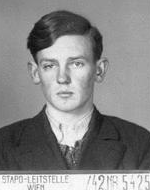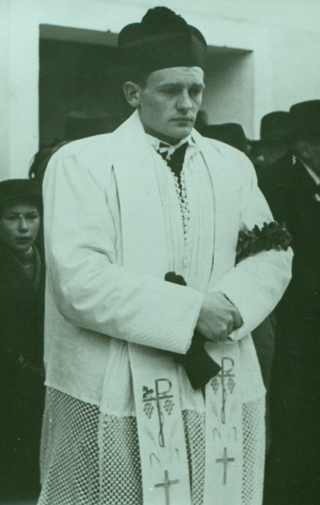Msgr. HR Dr. Anton Brunner

Personalia
Born:
Died:
Profession:
Persecution:
Imprisonment 1939 - 1940 (several months),
Imprisonment 20.01.1942 - 17.10.1944,
Punishment company 17.10.1944 - end of war
Death sentence: 28.08.1942
Pardon and commutation to prison sentence: 15.03.1943
Honors:
Grand Decoration of Honor for Services and the Republic of Austria
Memberships
Curriculum Vitae
Anton Brunner was born in Emmersdorf an der Donau. After elementary school, he attended the Stiftsgymnasium in Melk between 1933 and 1938 and transferred to the Stiftsgynmasium in Krems in 1938. There he also witnessed the invasion of Austria by the German Wehrmacht in March 1938.
In April 1938, Anton Brunner, who was not quite 15 years old at the time, joined the resistance group around his classmate Alfred Kraus and Karl Neumayer. This Austrian-Catholic group, which emerged from former members of the Austrian Young People, produced flyers with anti-Nazi content and distributed them in Krems and the surrounding area. When the group around Alfred Kraus was exposed in 1939, Anton Brunner was remanded in custody for several weeks, but was pardoned on December 9, 1939. He spends his 16th birthday in prison.
The Stiftsgymnasium in Krems, like all Catholic schools, is closed by the National Socialists. At the same time, Anton Brunner was expelled from all schools in the "Gau Niederdonau", which is why he transferred to the Kundmanngasse 22 grammar school in Vienna. There he meets his new classmate Josef Maria Landgraf.
The devout Catholic Josef Maria Landgraf listens to the forbidden broadcasts of the BBC and the "Sender of the European Revolution" on his family's radio set even before the outbreak of war. He reports the content of the broadcasts to his classmates and acquaintances and produces letters, flyers and stickers. The content contradicted Germany's official war reports from the front. He adopted the Victory sign "V" from Winston Churchill, which he used to decorate the leaflets.
Together with his other classmates Ludwig Igáli von Igálffy, Friedrich Fexer and Johann Trettler, they set up a network that posted the letters and distributed the flyers and stickers. Around 70 letters, 50 flyers and 20 stickers were produced.
Another classmate of the five fellow pupils, who had learned of their activities, contacted the principal of Kundmanngasse, Ferdinand Walter, who reported the pupils to the Gestapo. On September 20, 1941, Josef Maria Landgraf was arrested by the Gestapo. Ludwig Igáli von Igálffy and Friedrich Fexer were arrested on January 19, 1942 and Anton Brunner was finally arrested on January 20, 1942.
[Note: Johann Trettler was not arrested, especially as he had already been drafted into the Wehrmacht at the time he should have been arrested and the Wehrmacht refused to hand him over to the Gestapo. Johann Trettler died on September 26, 1942 in the Caucasus region.]
Anton Brunner is sentenced to death by the People's Court on August 28, 1942 for "preparation for high treason". He is pardoned on March 15, 1943 and his death sentence is commuted to five years' imprisonment. He is transferred to the Kaiser-Ebersdorf youth prison, where he meets up with his old friends from the Landgraf group. Like Friedrich Fexer, he was probably transferred to a punishment company ("probation battalion") of the Wehrmacht on October 17, 1944. He was injured in France and taken prisoner of war. There he experienced the liberation of Austria.
He returned from captivity in 1946, entered the seminary and enrolled in theology at the University of Vienna. In 1948, he joins the ÖVP-Kameradschaft der politisch Verfolgten und Bekenner für Österreich. In 1950, he received his doctorate and was ordained a priest. He then worked briefly as a chaplain in various parishes until he took over the pastoral care of Stein Prison on May 1, 1957. He remained there until he retired in 1987, but then took over pastoral care in the Krems prison and became moderator in Imbach. In 1995, Anton Brunner finally went into permanent retirement. He died in Krems at the age of 76.
[Note: The Landgraf group is often mistakenly counted as one of the "groups of four". The Vierergruppen are two other youth resistance groups against National Socialism that emerged simultaneously and independently of each other in the summer of 1941 in Hamburg and Munich.
Johann Trettler was a member of the group, but was not tried and convicted by the People's Court like the other four members. Nevertheless, the group had five members]

Places
Residence:
Place of activity:
Memorial:
Citations
- Diözesanarchiv St. Pölten
- Dokumentationsarchiv des österreichischen Widerstands (DÖW)
- Josef Landgraf (2021): Die weiße Rose von Wien. Geboren 1924 (Wien)
